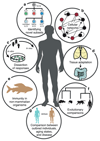Single-cell transcriptomics to explore the immune system in health and disease
- PMID: 28983043
- PMCID: PMC5654495
- DOI: 10.1126/science.aan6828
Single-cell transcriptomics to explore the immune system in health and disease
Abstract
The immune system varies in cell types, states, and locations. The complex networks, interactions, and responses of immune cells produce diverse cellular ecosystems composed of multiple cell types, accompanied by genetic diversity in antigen receptors. Within this ecosystem, innate and adaptive immune cells maintain and protect tissue function, integrity, and homeostasis upon changes in functional demands and diverse insults. Characterizing this inherent complexity requires studies at single-cell resolution. Recent advances such as massively parallel single-cell RNA sequencing and sophisticated computational methods are catalyzing a revolution in our understanding of immunology. Here we provide an overview of the state of single-cell genomics methods and an outlook on the use of single-cell techniques to decipher the adaptive and innate components of immunity.
Copyright © 2017, American Association for the Advancement of Science.
Figures




References
-
- Immunity in the tissues. Nat Immunol. 2013;14:977. - PubMed
-
- Perfetto SP, Chattopadhyay PK, Roederer M. Seventeen-colour flow cytometry: unravelling the immune system. Nat Rev Immunol. 2004;4:648–655. - PubMed
-
- Bajénoff M, Germain RN. Seeing is believing: a focus on the contribution of microscopic imaging to our understanding of immune system function. Eur J Immunol. 2007;37(Suppl 1):S18–33. - PubMed
Publication types
MeSH terms
Grants and funding
LinkOut - more resources
Full Text Sources
Other Literature Sources
Medical

